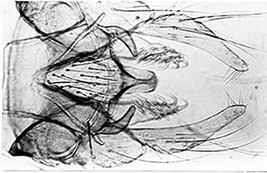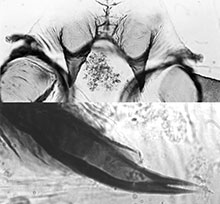Species 3gAdult: Based on a reared male: The specimen is in the Sublette collection, now in the museum of the University of Minnesota, St. Paul, MN. Only the hypopygium of this male is available for study: Tergite IX with 13 setae in individual pale spots within a triangular area. Anal point short and broad, Superior volsella dark and closest to E-type(g) of Strenzke (1959) but the tip more curved and more robust. Inferior volsellaV, with simple setae, reaching well past end of anal point and to about the midpoint of the gonostylus, which is moderately swollen and narrows genly over the posterior half. 
Male terminalia of C. sp. 3g. Pupa: Besides the associated pupal exuvia, there is a possibly associated pupa from Yankton, South Dakota collected by P.L.Hudson. Of these exuviae, only photographs of the cephalic tubercles and a pupal spur are available.
The cephalic tubercles have a length/width of about 1-1.6; there are no frontal warts. The spur of segment VIII has two separated spines. 
Cephalic tubercles (above) and spur of segment VIII (below) of C. sp. 3g.Larva (based on one female larva): a small (abt 11.4 mm) plumosus-type; posterior pair of ventral tubules slightly longer (ant. 1.01mm; post 1.13 mm). Lateral projections about 280 µm. Anal tubules about 405 µm long (dorsal) and 380 µm long and about 2.3-2.5 times longer than wide. Salivary reservoir about 81 x 25 µm (3.2 times wider than deep).
Gular very slightly darkened on posterior third, and frontoclypeus pale.
Mentum of type I-ii, with somewhat rounded teeth; c1 tooth relatively narrow with very short diverging sides, then rounded; c2 teeth moderately separated (type IIA-III).
Ventromental plates about 211 µm long and 3.7 times longer than deep; and and 3.7 times longer than deep; 1.13 times wider than mentum; separated by about 0.22 of mentum width with about 39-40 striae, VMR 0.32-0.35.
Pecten epipharyngis with 12 short, thick teeth (type B).
Antenna with A1 3.7 times longer than wide and 0.4 of VHL; RO about 0.41-0.42 up from base; AR 1.73; A2/A1 about 0.22. Segment lengths (µm): 121 : 36 : 11 : 15 : 9.
Distance between S4 setae (154 µm)just greater than distance between antennal bases (150 µm), and about 0.87 of Frontoclypeus width at that point.
Mandible with short thickened heel, length about 230 µm, 16 furrows on outer surface near the base, 3rd inner tooth partly separated and colored (type II-IIIB), Pecten mandibularis with 13-14 taeniae, 3 spines on margin; Mdt-Mat 28; MTR about 0.35. Cytology: 4 pairs of relatively short chromosomes with the thummi arm combination AB, CD, EF, G. Arm G short and usually unpaired with a subterminal nucleolus and an obvious median BR. There may be another BR associated with the nucleolus. No nucleolus in longer chromosomes.
Arm E often unpaired. Puff with distal dark bands just near the 4 characteristic bands of arm B. Found: Minnesota - Eagle Creek, Eagle Bend, Todd Co. (46.13°N, 95.05°W).
Possibly also: South Dakota - Yankton, Yankton Co. (42.56°N, -97.20°W) The cytology suggests that this species may be related to C. atrella (species i), however there are morphological differences: pale gula, anterior ventral tubules longer than posterior pair) and most notably in the cytology is the absence of a nucleolus in arm B; also the very broad anal point of the adult male.See also C. atrella.[ Return to Index| Go to References ] |